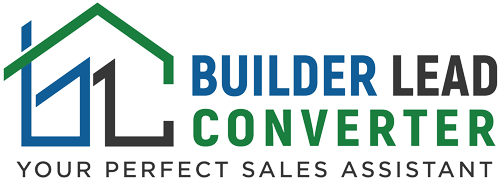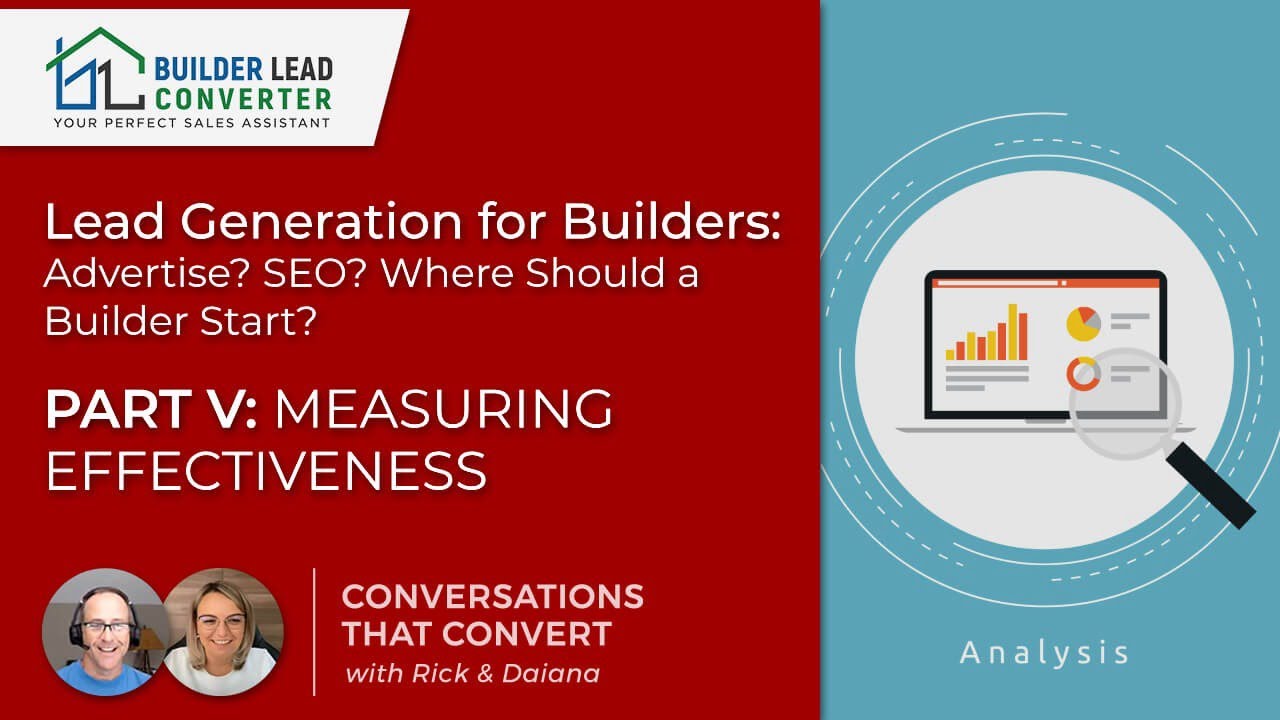Well, here we are, the final plunge into the deep end of lead generation for home builders and remodelers.
We’ve discussed in our previous episodes building a lead generation road map, plugging your current opportunity leaks, Search Engine Optimization (SEO) and 2 episodes on running ads.
How will you know if that shiny new social media ad or beefed-up SEO strategy is actually driving leads and conversions?
In today’s data-driven world, measuring lead generation effectiveness is not optional. If you’re not gaining insights into what’s working, then you might as well be throwing darts in the dark.
With a few simple measuring methods to follow, you can begin to see what’s moving the needle for your home building or remodeling business. So pour yourself another cup of coffee, read/watch/listen to this episode, and let’s dive into the metrics that really matter. Because when it comes to lead gen, what gets measured gets managed—and improved!
Builder Lead Converter ATTRACTS, CAPTURES & CONVERTS high-quality leads for builders so they can pick & choose their clients & jobs. Find out how at https://www.builderleadconverter.com
Transcript:
Rick: Today in Conversations That Convert, we’ll be talking about part five in our digital lead or our paid ads campaigns, and that is measuring the effectiveness of your campaign. What are the things that you should be measuring? And remember, you cannot manage something that you don’t measure. Let’s get started.
Welcome to Conversations That Convert. Every week we’ll spend about 10 to 15 minutes tackling relevant lead generation. Marketing and sales topics for remodelers home improvement companies and home builders Conversations that Convert is brought to you by Builder Lead Converter, your perfect sales assistant. And now here’s Rick and Daiana
Rick: Welcome to Conversations That Convert, everyone, Daiana. You look lovely today
Daina: Thank you. Thank you. Welcome, everybody. It’s an exciting session today because we’re going to measure some effectiveness. It’s part five of our lead generation for builders.
Rick: That’s right. And this is the last part. In our five-part series, and this was all about lead generation for builders, and it’s based on the number one marketing challenge that was identified by the Association of Professional Builders, the state of the residential construction industry annual survey. So a thousand builders were surveyed.
The consensus was number one marketing challenge was generating high-quality leads. So we put together a five-part series on that. And just to recap, we started with setting up your roadmap. Then we went into a plugging your opportunity leaks. We talked about search engine optimization with our friend Jens Rhodes from Floodlight SEO.
Then we moved into digital and offline paid ads. And then today we’ll be talking about measuring for effectiveness. In other words, if you are going to go ahead, you are going to set up a paid ad campaign. How do you know if it’s effective? And that’s, I think, one of the biggest challenges out there. Is a lot of builders will jump in feet first into an advertising campaign, whether they’re trying to do it themselves, or maybe they hire some sort of an agency to run the ads for them.
And there’s just not a good what we call ROI KPIs. So key performance indicators, how is the campaign doing? Are you getting your money’s worth? What should you be looking for as a builder? What should you be measuring? So we’re going to jump in and talk about, I’m going to talk about four. Key measurements today.
And as I alluded to in the beginning is you cannot manage what you don’t measure. So a lot of times marketing agencies will measure things like a click-through rate or impressions or things like that, which click-through rate and impressions. It’s really like because you can put an ad out there and if it gets clicked on a bunch, but it doesn’t generate any leads, who cares?
So it might make you feel good that you’re getting thousands of impressions per week on your particular ad. But if it’s the ad is not producing the results you’re looking for, which is obviously a highly qualified lead, it’s really not worth the effort. And the money that you’re putting into it. So we’re gonna talk about four simple measurements today.
I want to break this down as simple as possible. You don’t have to make this complex. There are so many, you can get go off on a lot of different rabbit holes when it comes to measuring the effectiveness of ads, but let’s just break it down into these. For simple tools. So what do you say, Daiana? Should we jump in?
Daina: Yes, let’s jump in.
Rick: All right. So number one, you want to measure the offer. So what is the offer? The offer is simply the call to action in the ad. And you’re answering the offer is simply, what do you want the lead to do? So the offer could be maybe to click to receive something of value and get some information.
It could be to pick up the phone and to call you. It could be to come to a certain location. Like if you have an event or perhaps a model home or some sort of open house, you want the lead to drive there. And keep in mind the greater, the. effort the lead has to put into it, the lower the conversion.
So in other words, it’s a lot easier to get a click than it is to get someone to hop in their car and drive to your location. So one thing, why you’re going to measure this is because this metric will tell you if your offer is any good. So that was, you can put all sorts of offers out there, but if nobody’s clicking on it, the offer is not any good. It means you need to change it up. Any thoughts on this Daiana?
Daina: I think that makes sense to just stop and analyze and see what’s what’s the, what’s best for you. If any, it’s worth the effort to do.
Rick: This goes back to having multiple ad campaigns with doing different offers. And so you might find out that one offer converts really well and one offer doesn’t. So you know what, expand that offer and, and get rid of the offer. That’s not, that’s not working well. So again, keep in mind that the lead does not care about you until they feel you care about them. So a compelling offer is something that’s going to be highly valued by that lead.
And I always say, you know, again, it goes onto those three things. It’s design, it’s price, and it’s location. Any sort of offer you can give them related to helping them understand what they can build. Helping them understand how much it will cost and helping them understand where they can build it. If it’s a new home, obviously where they can find land, or if you’re in remodeling, sometimes simply just identifying a service area is the type of offer you need to focus on.
But design and pricing, what I have found are always the best offers, anything to revolve around that. All right, let’s jump into number two. So second thing I want to measure is your capture rate. So in other words, you put an offer out there, which is your ad. People see that ad, people will click on that offer.
Then they’re going to go into a lot of times that we call this is a landing page. So, landing page again will be another term for it, a squeeze page, but it’s where you’re doing, what you’re doing here is you’re incentivizing the lead to leave their contact information. Now the other type of advertising you can do is just to drop people onto your website, or it could be something simply where you want them to pick up the phone and call you.
But just remember, the more you ask them to do, the lower your conversion rates. I like doing a click-type offer. In other words, because it’s simple, and I can really build up my database very quickly. And then I can work that database road, you know, through nurturing campaigns, through cold lead reactivation through event management, you know, and things where I can build a relationship with them over time, establish trust, and establish value. So the contact information is important here.
Now, I’ve heard some clients say, well, I don’t want to ask too much. I’m just going to try to get the name and the email. Keep in mind, that email is the worst form of follow-up that we have out there. It’s the least effective form of follow-up. So anytime you’re doing a landing page here, you always want to include a cell phone number. Very, very important to get a cell phone number.
Because now I can then send a text message. I can also call them as part of my follow-up. If you’re only getting an email, I would say it’s not worth doing what you’re doing because trying to get them ultimately to convert into an appointment using only email is very, very difficult. So, Daiana, any thoughts here?
Daina: It sounds like yeah, it’s important to also have the contact information, a clear call-to-action, and I’m curious what’s next.
Rick: So and that’s important to you, right? You get on that landing page is like you always have to be thinking that is what’s in it for them. Why would they want to take the next step with you and fill out that information? So number one, I have to make it very compelling, but also I have to build confidence and so confidence things like I may want to have testimonials on that landing page.
I might have a video testimonial. I’m going to put yes maybe some some of the associations that you belong to. If you’re a member of like local organizations, like a Chamber of Commerce, your local home builders association, that sort of thing. That’s going to help build confidence as well.
So the next thing that I measure will be the conversion. Okay. So. Number one, I’ve got the lead to click on my ad. They go to a landing page. I’ve captured their information on the landing page. So the next thing I want to do is I’m going to put them into a follow-up campaign and I want to convert that lead into an appointment. So that’s the next thing that I’m going to look at.
Now, this is a much more difficult thing to do than simply even just getting their contact information but getting them to actually want to talk to you. Into a conversion campaign. So conversion campaigns are broken down in a lot of different ways. Number one is usually you give them the deliverable.
So whatever you promised them, you give them first. Then you go put them into more of a welcome campaign. That would include an indoctrination campaign where they learn more about you, put them into an ascension campaign, which is really getting them to want to move into that relationship with you, which would start with a phone call to talk more about their project.
So lots of different things happening there that happen over time. It’s not gonna, some people will maybe convert right away. For other people, it could take months to get them to convert. And, drum roll please, the last but certainly not least, the all-important sale, right? It’s like, why are we doing this? Well, we’re doing this to get a sale.
So, we start with the click, we move to the capture, we move to the conversion, which is moving them into an appointment, and then ultimately, did they get did they go to contract?
And so all of this can be done automatically. You can put tracks, tracking pixels, and things. So when people drop on your landing page, you can track which ad campaign they came from, and which platform they came from, and then you can stamp that on the lead. And then as they go through your sales process and ultimately you sell them, you can go back and look, Oh yeah, look. This came from an ad from house or this person came from an ad on you know, Google local services as an example.
And then you can say, all right, yeah, this I’m getting my return on investment. Let’s keep advertising here. And you look at your other campaigns and if they’re not producing any results you can then end those campaigns. So Daiana, some final thoughts here.
Daina: So four easy steps to follow to make sure that you measure your leads and capture the appointments.
Rick: Yeah, capture the appointments and ultimately get them into a sale. Now, if you’re capturing, getting people into an appointment, but you’re not selling them, part of that could be your own sales process. So it may not be that the ad is underperforming or the platform is underperforming. It’s delivering you opportunities.
It may be that your sales process is not the best and you’re underperforming. Or it could be just that you’re getting too low of a quality lead. You know, I see you know, one of the really easy platforms to get leads on and Facebook is called Lead Ads. It’s where simply the person on Facebook, the form is autofilled on Facebook.
All I have to do is literally click on the ad and click submit. So it’s really easy to get those leads, but it’s a very low-quality lead. So you have to go through a ton of them to get somebody that’s even remotely close to wanting to build in the higher price point that you offer, the lower the chances are that’s going to be a higher quality lead.
So that’s one issue you have with paid ads. The other issue again, might be again, your sales process, but final thoughts on this and regarding the quality of leads, your cancellation rate may be higher on paid ads because again, it is a lower quality lead. So keep in mind that paid ads are typically going to have a higher cancellation rate.
You want to adjust your ads monthly if they’re underperforming. So an offer that is working today, it may not work tomorrow. And so what I usually, you know, tell our builders about offers is that the best offer will mirror the market sentiment. You know, so right now the market in your area might be real strong.
So your offer should mimic whatever the challenges are of the current leads in the marketplace based on current market sentiment. Now that also goes to maybe the market’s weak in your area. So in other words, buyers have the upper hand. There’s a lot more sellers than there are buyers. So then your offer needs to be more compelling to get those people that are sitting on the fence to make the leap and start the process with you.
The effectiveness of the offer will change based on the time of the year. So, you know, a lot of times in the fall, you get people that are more planning to do something the following year. In the springtime, leads are a little bit hotter. They’re willing to take action right away. So, again, that offer might change and should change, I should say, based on the time of the year.
And then the other thing that I mentioned this before, I’ll mention, it’s worth mentioning again. I’m not a proponent of running ads when there’s really nobody in the marketplace. So in other words, a lot of times during the holidays there’s not a whole lot in the marketplace right now. And I, there’s two schools of thought.
One school of thought is, well, nobody’s advertising right now. So I’ll advertise. The other school of thought is. Because nobody is in the market right now, I’ll save my ad budget and I will spend it when there’s more buyers out there. The latter is my school of thought. Save your ad budget, and spend it when there’s more opportunities out there.
Because I look at it and say, you can probably design a better ad than your competitors and then you can pick up market share from them. So that is my final thought. Every market, every product type is different. Somebody who’s an empty nester wanting to build in Florida they may, you may have a different peak market time down there.
And based on the type of product that you’re selling say a Villa Association maintained might is going to affect be different than say. A design-build modeler or say a single-family home builder, you know, that’s doing something different. So you’ve got to really hone that in on your own market. And that just comes down to this testing and seeing when the best times are to pick up. So our leads, excuse me, Daiana, have final thoughts here before we wrap.
Daina: So my final thought is to just be flexible and adapt and listen to the market, and then the market will tell you what to do.
Rick: Absolutely. Couldn’t, have done it any better myself.
So if you’d like to know more about how we can help you attract, capture, and convert high-quality leads so you can pick and choose your clients and jobs. Let’s go ahead and click on the schedule your strategy call below. Be happy to learn more about your company and see if we might be able to help you with that.
And if we can’t, you know, we’ll point you in the right direction to another company that maybe could do a better job than us. So for my brothers and sisters in Christ, may the grace of the Lord Jesus Christ, the love of God, and the fellowship of the Holy Spirit be with you all. Always. We’ll see you next time on Conversations that Convert. Bye, everyone.






Recent Comments